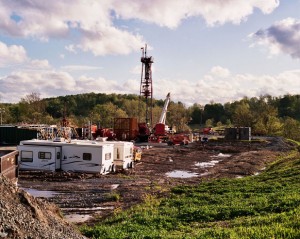
Dang! Bob Katter is making more sense today, putting his finger on the primary problem with Australia’s new “sell ’em dirt” development model. From the AFR:
What do you call an industry that doesn’t create many job opportunities, doesn’t provide significant revenue for the economy and destroys structural homeland industries through systemic and endemic collateral damage?
It’s called the coal seam gas industry.
…And let me be specific. Coal seam gas when mixed with water will contaminate it; poison may not be too strong a word.
I am not an expert on the technicals of fracking but this post by the Unconventional Economist offers a guide to the risks to the water table. More to the point, Katter describes why our current economic model comes with a serious risk:
Why are the Queensland, NSW and to date the federal governments so intractable in their determination to progress this industry?
They tell us many jobs and vast revenue will accrue to Queensland and Australia. We are told a projected $60,000 million a year in revenue. And this is correct.
But what we are not told is there will also be $60,000 million a year in outgoings overseas.
The vital point to grasp is that more than 80 per cent of the industry is foreign-owned and a further 10 per cent is on the foreign auction block.
As I’ve described vis-a-vis floating LNG, the major benefit of the projects is the tax revenue (though being onshore means CSG will provide proportionately more jobs and activity than FLNG). Unlike Bob, I’m not in any way opposed to foreign capital making dough on Australian soil. But I am concerned that in backing the one trick pony of extractive industries we end up with an improved national balance sheet at the expense of the sustainable productive capacity of the economy. We all know where that improved national balance sheet will be put. Whether via tax cuts, grants, bank guarantees or some yet to conceived inflationary mechanism, it will go into leveraging up the property market.
Meanwhile, a higher dollar and interest rate structure will prevent non-mining tradable sectors from growing (and probably shrink them). In the long run, as the price of mine output falls, we will have hollowed out our non-mining export industries and be left with holes in ground, big government and very expensive and toppy house prices.
If, in the case of CSG, there is also a direct impact on the viability of food production, another non-mining tradeable, then the equation becomes even more questionable over the long term.
Then again, if you think the price of your gas will never go down, there is no economic problem (water table poisoning is another matter). But that strikes me as one wild punt.
So, assuming that Katter is right about the dangers of fracking, I would argue that the issue is not foreign capital per se but the market failure (or false economy) that gives Australia an even more virulent dose of Dutch Disease over time.
It is no mystery why governments of all stripe are headed down this path. They are beholden to mining interests, terrified of altering property incentives and can’t think past the next election.

